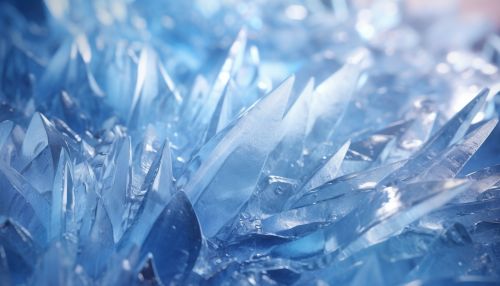Ice
Introduction
Ice is a solid phase, usually crystalline, of a non-metallic substance that is liquid or gas at room temperature, such as carbon dioxide ice (dry ice), ammonia ice, or methane ice. However, the predominant use of the term ice is for water ice, technically restricted to one of the 19 known solid crystalline phases of water. In non-scientific contexts, the term usually means ice Ih, which is known to be the most abundant of these solid phases. It can appear transparent or a more or less opaque bluish-white color depending on the presence of impurities or air inclusions.
Formation and Characteristics
Ice forms when the water temperature reaches or drops below the freezing point, 0 degrees Celsius (32 degrees Fahrenheit) under standard pressure conditions. The process of ice formation involves the slow arrangement of water molecules into a definite crystalline structure known as a lattice. This lattice formation results in the expansion of water as it freezes, making ice less dense than liquid water, a unique property among most substances. This is why ice floats on water read more.
Ice exhibits a hexagonal crystalline structure, which is responsible for its unique characteristics. For instance, the hexagonal structure gives ice a lower density than liquid water, allowing it to float. It also results in the unique six-fold symmetry of snowflakes read more.
Types of Ice
There are several different types of ice, depending on the method of formation and where it is found. These include:
- Glacial ice is formed from the accumulation and compression of snow over time. It is found in glaciers, ice caps, and ice sheets read more.
- Sea ice forms when ocean water freezes. It plays a crucial role in regulating the Earth's climate by reflecting sunlight back into space read more.
- Lake and river ice forms on the surface of freshwater bodies during the winter months. It can pose both a hazard and a recreational opportunity read more.
- Hail is a type of ice that forms in thunderstorms when updrafts carry raindrops upward into extremely cold areas of the atmosphere read more.
- Frost is a thin layer of ice that forms on solid surfaces when the temperature drops below the freezing point of water read more.


Physical Properties
Ice has unique physical properties, many of which are a result of its crystalline structure. These properties include:
- Density: Ice is less dense than liquid water, which is why it floats. This is due to the hexagonal crystalline structure of ice, which takes up more space than the random arrangement of molecules in a liquid.
- Melting and Freezing Points: The melting and freezing points of ice are the same: 0 degrees Celsius (32 degrees Fahrenheit) at 1 atmosphere of pressure. However, these points can be changed by the presence of impurities or by applying pressure read more.
- Thermal Conductivity: Ice is a poor conductor of heat, which means it takes a long time to melt, especially in large quantities. This property is utilized in various applications, such as ice storage and ice houses read more.
- Optical Properties: Ice is transparent to visible light but absorbs slightly at the blue end of the spectrum, giving it a natural blue tint. It is also highly reflective, which is why large ice formations and snow can appear white read more.
Uses of Ice
Ice has a wide range of uses, from the practical to the recreational. Some of these uses include:
- Cooling: Ice is used to cool drinks and food, in medicine to reduce swelling and inflammation, and in industry for various cooling processes read more.
- Recreation: Ice is used for recreational activities such as ice skating, ice fishing, and ice sculpture creation read more.
- Climate Research: Ice cores from glaciers and ice caps are used in climate research to study past atmospheric conditions read more.
- Construction: Ice has been used in construction, for example in the creation of ice roads and ice hotels read more.
Environmental Impact
The presence or absence of ice, particularly sea ice and glacial ice, has significant impacts on the Earth's climate. The melting of ice due to global warming is a major concern as it contributes to sea-level rise and loss of reflective surfaces, leading to further warming read more.
